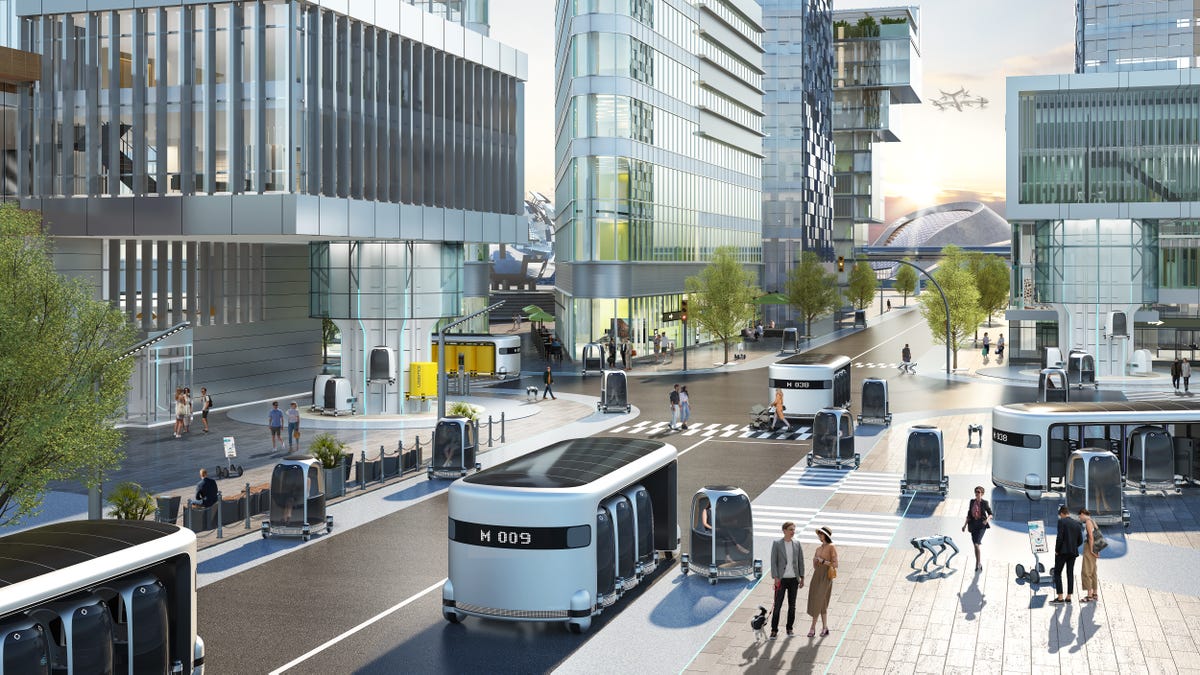Hyundai's AV pod concepts promise better living through modularity
The automaker's CES 2022 concepts include transparent PnD people-mover pods and emergency rooms that come to you, all based on modular robotics technology.
Hyundai's vision for the future of transportation is a modular one. At CES 2022, the Korean automaker and robotics company debuted a series of mobility concept vehicles and transport robots built around its conceptual Plug and Drive and Drive and Lift modules.
You can usually count on Hyundai to bring the weirdest, wildest forms of future mobility to CES. In 2019, it was the walking Elevate concept. At CES 2020 it showcased the S-A1 Urban Air Mobility Concept, which makes a surprise cameo appearance again in Hyundai's refreshed vision of tomorrow.
The Plug and Drive module integrates steering, suspension, electric motor and brakes into a compact pod that also features lidar and camera sensors.
Most of Hyundai's new mobility concepts are built around the Plug and Drive Module, or PnD, an electric pod that integrates 360-degree steering, electric motors and brakes, a 5.5-inch wheel with airless tires, and lidar and camera sensors into a modular package that can be applied to a wide range of vehicles and transport bots. For example, placing four at the base of a storage pod creates an autonomous roving PnD Logistics kiosk that could deliver packages or your dry cleaning. Hyundai even features an example that can deploy a Boston Dynamics Spot robot "dog" to, presumably, carry the packages for the last yard or to places the PnD Logistics can't go, like up stairs to your doorstep.
One of the most interesting potential applications of the PnD modules is the PnD Personal individualized mobility cabin, a single-seat, transparent person-moving pod intended to help people of limited mobility get around. Being based on the autonomous PnDs, the mobility pod should also be capable of autonomous operation, but a joystick allows manual operation. Hyundai envisions these mobility pods docking with a building's elevator system, rolling around town alongside pedestrians and being loaded into larger Mother Shuttles that allow multiple pods to be moved as a platoon -- sort of like a bus, but smaller and your co-passengers, each in their own pod, can't breathe on you.
The PnD Personal, shown here docked in a Mother Shuttle, is a bit like those powered chairs from Disney's Wall-E.
Each Mother Shuttle concept appears to hold eight pods, which are transported autonomously over longer distances and at higher speeds. The Shuttle rolls on four PnD modules that are larger and more powerful than the ones on the individual mobility pods, but still feature the same 360-degree steering at each corner that boosts maneuverability.
Another potential application of larger PnD modules is so-called purpose-built mobile spaces like the Hospital Mobility concept, a rolling hospital or trauma center that could be deployed to the site of large emergencies like earthquakes or fires. For really big emergencies, multiple Hospital Mobility pods could connect to form a larger Hospital Pavillion once onsite to allow doctors to collaborate to serve a larger number of patients. Personally, I like to imagine a bunch of PnD-powered food trucks rolling up to form an impromptu Snack Pavillion during, say, a music festival.
The L7 concept applies the modular PnD pods to a modular platform that can scale for personal mobility or cargo transport.
The PnD modules also form the backbone of the L7 concept, another electric micro mobility platform designed with scalability in mind. L7 uses larger, 12-inch PnD modules at each corner of a Lego-like modular platform that can be configured to accommodate a single seat that rotates for ease of access or reconfigured to an elongated skateboard design that can carry packages or equipment.
In addition to the PnD ecosystem, Hyundai also showcased its Drive and Lift modular mobility system. Like PnD, DnL integrates drive, steering and braking systems into a single module, but places that package at the end of a rotating arm that allows each wheel to articulate and lift independently. This allows neat tricks like leaning into corners to stabilize loads during high-speed turns or keeping a load perfectly level over uneven terrain, over speed bumps and even up stairs. Personally, I would love to see an electric sports car that can carve and lean into corners like a motorbike, but for now, Hyundai is thinking a bit smaller.
MobED, a tour guide and telepresence bot, is a compact application of the DnL modular platform.
Hyundai is looking into both manned and unmanned applications for DnL, with the first being MobED, a 24-inch wide by 27-inch long guide bot. Built around a 2-kilowatt-hour battery and featuring a tabletlike screen on an articulating arm, MobED can serve as a tour guide or telepresence bot.
Hyundai, like most of the tech world, is also delving into the weird world of the metaverse and bringing its unique robotic flare along for the ride.


